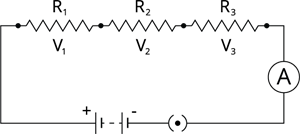
PUMPA - SMART LEARNING
எங்கள் ஆசிரியர்களுடன் 1-ஆன்-1 ஆலோசனை நேரத்தைப் பெறுங்கள். டாப்பர் ஆவதற்கு நாங்கள் பயிற்சி அளிப்போம்
Book Free DemoA system of resistors is a combination or a group of resistors in a circuit.
The resistors can be connected in different combinations to form an electric circuit. But, there are only two basic methods of joining resistors. These are:
a) Resistors in series
b) Resistors in parallel
We can easily compute the effective resistance of resistors with different resistance values when it is connected in series and parallel.
Resistors connected in series:
In a series circuit, the electrical components are connected in a single loop, one after the other. The electric charge in a series circuit can only flow in one direction.

Series connection of resistors
If the circuit is broken or disturbed at any point in the loop, the current cannot flow through the circuit, and hence electric appliances linked to it will not function.
Let the resistances of three resistors be R_1, R_2 and R_3, connected in series, and 'I' be the current flowing through the circuit. According to Ohm's law, the potential differences V_1, V_2 and V_3 across R_1, R_2 and R_3, respectively, are given by
The sum of the potential differences across the ends of each resistor is given by
Substituting the values of V_1, V_2 and V_3 in the above equation, we get
---- (eq. 1)
A single resistor that can effectively replace all the resistors in the electric circuit to maintain the same current is known as an effective resistor.
Let R_S be the effective resistance of the series-combination of the resistors. Then, the (eq. 1) becomes
V = I\ R_S
On substituting the values of effective resistance V in (eq. 1), we get
Important!
In a series circuit, the effective or equivalent resistance is equal to the sum of the individual resistances of the resistors.
When 'n' number of resistors with an equal resistance 'R' are connected in series, their equivalent resistance is given as 'n R'. Hence,
R_S = n R
Important!
The equivalent resistance in a series combination is greater than the highest of the individual resistances.
From the diagram, it is deduced that the current 'I' remains constant throughout the series circuit. In other words, the current in every point or junction of the circuit is the same.